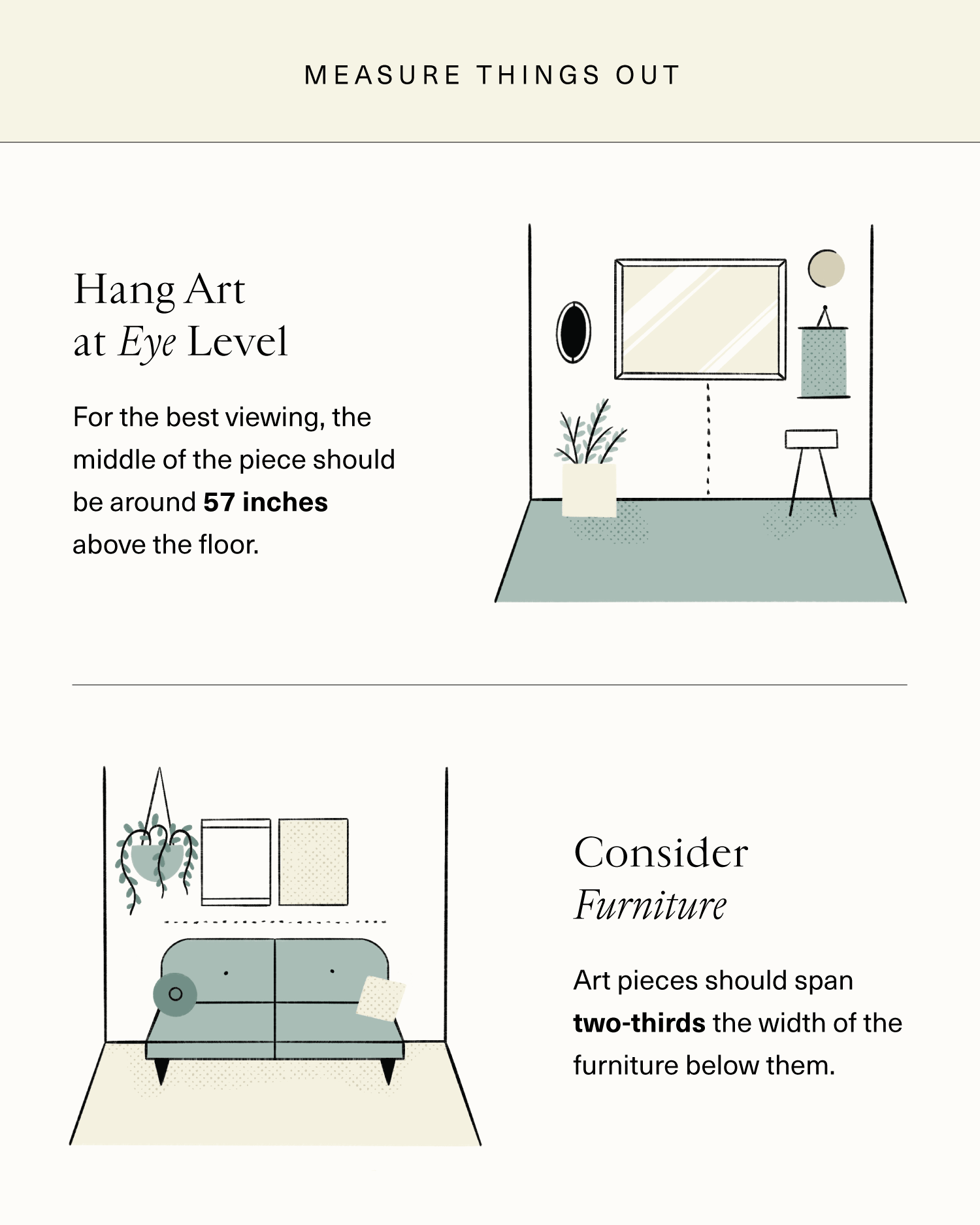Hanging up art can be a daunting task, especially if you’re planning to place multiple pieces on a single wall. Here, we’re sharing four pointers, along with illustrated tips courtesy of 1stDibs’ blog, to help you create the best art wall for your space.
Integrate Art With Your Design
Choose Your Style
Make Measurements
Create Visual Balance
Integrate Art With Your Design
Don’t let art be an afterthought in your interior design. Consider your new and existing decor pieces, furniture, and overall style when choosing new paintings. Thinking about art placement and color coordination in the first phases of your design process will help create a more integrated and artful room.
If you’re having trouble picturing your setup, digital tools will come to your rescue. For example, our Digital Art Staging services can help you envision different pieces on your wall.
If you want to experiment with different gallery wall configurations, a tried and true method is to use kraft paper and painter’s tape. Cut out pieces of kraft paper that are the same size as each of your art pieces, and then tape them to the wall to try out different placements and spacing options. When you find the arrangement that works best for your space, mark the kraft paper placement with a pencil and start hanging up the real pieces.
Choose Your Style
There are so many creative art wall arrangements to choose from, but a good place to start is deciding between a symmetrical or asymmetrical style.
A symmetrical arrangement, like a grid or triptych, is orderly, with a window-like formation. This is achieved with multiple works of the same size and framing.
An asymmetrical arrangement, like a salon-style gallery wall, leaves more room for creativity. It lends way to pairing different styles and sizes of art, but can be more difficult to arrange and keep balanced.
Barsky Gallery helps to arrange and hang gallery walls and fine art groupings in Hoboken NJ homes.
Make Measurements
You may have heard the advice to place the middle of a piece at eye level, at about 57-60 inches. However, there are exceptions to this rule. If you are placing art in a living room, for example, where guests are more likely to be sitting than standing, hang the art a little lower than 57 inches.
On the other hand, if you are hanging art directly above a piece of furniture, make sure the arrangement spans about ⅔ the width of the furniture below it. If you’re placing a piece above a sofa, think about the height of a person’s head while seated, and if you’re okay with heads overlapping with your art. If not, hang it higher.
Similarly, if you’re positioning a piece of art above a console table, think about leaving enough space for decorative items like vases to sit on the table without blocking the art.
Keep It All Balanced
It’s a challenge to maintain a cohesive sense of balance when hanging up art of different sizes on the same wall. However, there are some quick rules of thumb to help guide you.
When hanging up different-sized pieces of art in a linear row, line up the middle of the pieces instead of the tops or bottoms.
For a more complex gallery wall, first decide where the center of the arrangement will be. Will the gallery wall span the width of the entire wall, or will it be contained within a smaller section? Once you’ve chosen the exact middle for your gallery wall, mark or imagine a line down the center, from floor to ceiling.
Then, as you plan your arrangement, keep the visual “weight” equal on both sides of this line. That could mean placing a similar number of large and small works on both sides. You can also space out the pieces with the boldest colors across both sides of the line. Step back frequently as you hang up pieces to make sure everything feels unified.
The art you display in your home should feel authentic and personal to you, so don’t let the “rules” of hanging wall art hold you back. However, with these pieces of advice, you may have an easier time deciding how best to arrange your unique art displays.
Need a professional’s opinion? Our friends at Hoboken, NJ Art Services can help you choose and curate the perfect collection for any room.




